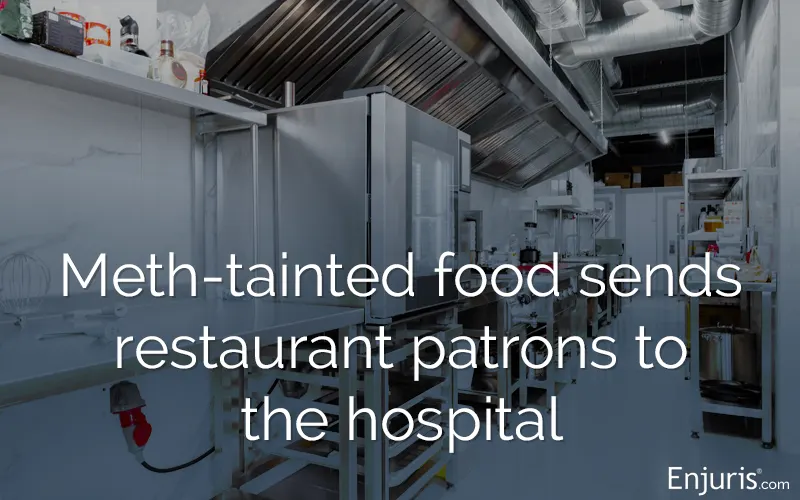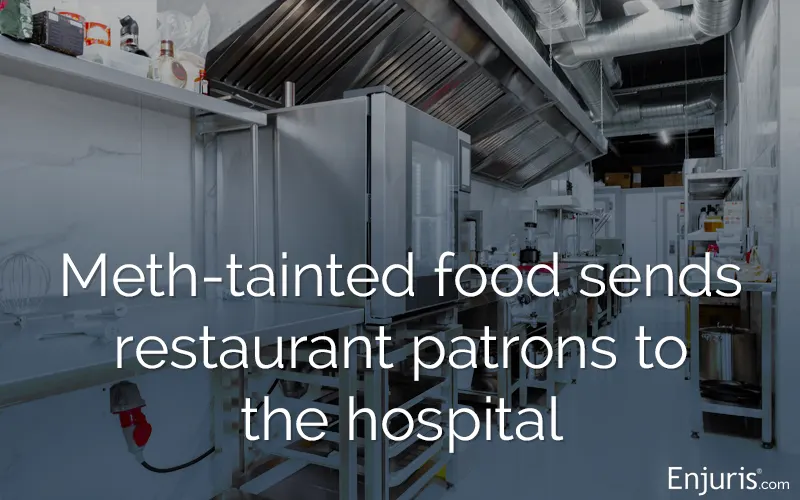[ad_1]

A restaurant operates under a legal standard of strict liability
We know that there are marijuana edibles available in a lot of places, but we don’t expect meth or other drugs to be literally served on our plates in a restaurant.
A restaurant is responsible for more than just providing a tasty meal and a decent atmosphere. Restaurants, as purveyors of food and beverages, play a critical role in ensuring public health and safety. Their responsibilities extend beyond providing enjoyable meals; they are also legally and ethically obligated to ensure that the food they serve is safe for consumption. This brings into focus the concept of strict liability in the context of tainted food served at restaurants.
A lawsuit was filed in late 2023 against Nikko Japanese Steakhouse in Pace, Florida, for three customers who claim to have eaten food tainted with methamphetamine.
These plaintiffs seek more than $100,000 in damages for the restaurant’s alleged negligence after they were hospitalized the previous spring. On June 10, 2023, seven people who had eaten at the restaurant were hospitalized; three tested positive for methamphetamine. The lawsuit contends that the restaurant’s food leftovers that the patrons brought home tested positive for methamphetamine.
The restaurant is now closed, but the lawsuit claims it’s liable for selling food and beverages that were “defective, dangerous, or otherwise not reasonably fit for consumption.” The lawsuit alleges strict liability, breach of implied warrant, negligent failure to warn, and negligence.
Strict liability in the restaurant industry
Strict liability is a legal doctrine that holds an entity responsible for damages caused by its actions or products, without the need for the injured party to prove negligence or fault. In the restaurant industry, this concept is particularly relevant in cases where patrons suffer from foodborne illnesses due to tainted or contaminated food.
In other words, if a patron becomes ill from eating restaurant food that’s somehow tainted—whether by a foodborne pathogen like salmonella, injured by a foreign object in the food, or something else—it’s reasonable to ascertain that regardless of how careful the restaurant was about food safety, the food caused the person’s illness.
No-fault requirement
Unlike other forms of liability that require proof of negligence or intent, strict liability applies regardless of how careful the restaurant was in preparing and serving the food.
Focus on food safety
This legal principle underscores the importance of food safety practices in restaurants. It encourages establishments to adhere strictly to health regulations and guidelines.
Consumer protection
Strict liability is a protective measure for consumers, ensuring they have legal recourse in the event of illness or injury caused by unsafe food.
Enhanced safety measures
The rule of strict liability has prompted restaurants and regulators to implement more rigorous food safety protocols, including regular health inspections, employee training, and quality control measures.
Methamphetamine-laced food in restaurants
Methamphetamine is a powerful and highly addictive drug that could be in the form of pills, powders or crystals. It’s a stimulant and speeds up the body’s central nervous system. While there are limited uses by prescription for medical problems, it’s most often a recreational drug.
Symptoms of meth exposure could include:
- Watery, red, and burning eyes, often accompanied by discharge and pain
- Irritation of the mucus membranes, especially in the nose and throat
- Skin irritations, redness, and rashes
- Chest pain and difficulty breathing
- Abdominal pain and diarrhea
- Chronic sneezing, coughing, and congestion
- Adverse effects on the central nervous system
- Moderate or severe headaches
- Dark-colored urine
- Rapid heart rate
- Yellow jaundice
- Fever
- Impairment in mental capabilities
- Hallucinations
The issue of methamphetamine-laced food in restaurants, though less common than other forms of food contamination, presents a unique and serious challenge. When restaurants inadvertently serve food tainted with substances like methamphetamine, the potential for severe health risks and legal consequences becomes significant.
Investigative challenges: Determining how methamphetamine ended up in food can be complex. It could be due to criminal activity, contamination of ingredients from suppliers, or even accidental contamination from an employee. Regardless of the cause, the restaurant could still be held liable.
Scrutiny of supply chains: To mitigate risks, restaurants must exercise due diligence in vetting their suppliers, ensuring that ingredients are sourced from reputable and safe sources.
Employee screening and training: Restaurants might need to implement stringent employee screening processes, along with training programs focused on food safety and substance abuse awareness.
Legal and insurance considerations: Establishments must know their legal responsibilities and ensure adequate insurance coverage to protect against such liabilities.
Emergency response protocols: It’s crucial to have a plan in place to respond to food contamination incidents, including communication strategies and medical response plans.
Marijuana/THC in food
If you’ve been a young adult in the past three decades, you’ve been cautioned about being “roofied.” This is a slang term for when a person intentionally slips the drug Rohypnol into an unattended drink to cause the consumer to lose consciousness. One reason Rohypnol is so dangerous is that it’s tasteless, colorless, and odorless—making it virtually undetectable in a drink. Bar patrons (primarily women, but men, too) must be sure never to leave a beverage unattended or accept a drink from anyone other than a server or bartender. Party-goers should also be wary of drinks served at private events.
But with the rise in edibles—food products infused with cannabis extract—it can be difficult to be sure that your food is not, in fact, laced with THC, or tetrahydrocannabinol.
| What’s the difference between CBD and THC? | |
|---|---|
| CBD: Cannabidiol | THC: Delta-9-tetrahydrocannabinol |
| Active ingredient in cannabis that is derived from the hemp plant | Psychoactive ingredient in cannabis plant (changes how your brain works) |
| Does not make a person “high” and is not addictive | Makes the user feel “high” after smoking marijuana or eating an edible |
| Can be found in oils, extracts, patches, vapes, and lotions | Comes in herbs or flowers, hash/hashish, and hash oil. The herb can be smoked or added to food or drink. |
While lots of people consume edibles on purpose, many would not choose to do so.
Accidental consumption of marijuana is no longer uncommon, particularly accidental consumption by children. Consuming marijuana in food is more dangerous than smoking it. When you smoke marijuana (i.e. “weed”), the effects can appear in minutes. But when you eat edibles, the effects can take one to three hours to happen because the food is absorbed into the bloodstream through the liver. That means it’s harder to measure the amount of THC being consumed in food and makes it easier to overdose, particularly if you’re not aware that you’re eating laced food.
Can you avoid eating marijuana-laced food?
Probably. If you’re at a private party, consider how well you know the hosts (and any other guests who might have brought food). One thing to be aware of is that there are a lot of typical packaged foods that look like traditional packaging but have a small stamp that indicate that they contain THC.
Edibles are now legal in all 50 states, so it’s important to check packages carefully before you purchase or consume foods like candy, chips, and other snack items. Many dispensaries carry edibles in a section that looks like a candy shop—they are often cookies, brownies, gummies, and similar. However, there can be cannabis in beef jerky and other savory treats. There’s even a Netflix show, Cooked with Cannabis, in which chefs demonstrate how they incorporate this “ingredient” into their dishes.
The best way to avoid accidentally consuming an edible is to check labels and be unafraid to ask questions. Whether you’re at a party, restaurant, bar, or elsewhere… if you’re not sure, don’t hesitate to ask the person hosting or serving food or drinks.
Who is liable for a drug-laced food illness or injury?
If a person intentionally adds any drug substance to someone else’s food or drink without their knowledge, they can certainly be liable for any repercussions—including illness or injury—that arise as a result.
Likewise, the strict liability standard mentioned above would apply to not just meth-tainted food but also any other drug or substance.
If a person becomes ill or injured because of drug-laced food, they can file a lawsuit against the person or entity whose negligence allowed the food to become contaminated.
If you believe you’ve become ill from tainted food, contact a personal injury lawyer for guidance based on your specific circumstances.
Tell your story:
[ad_2]



